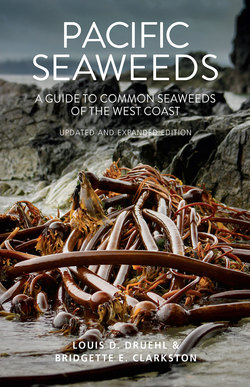Читать книгу Pacific Seaweeds - Louis Druehl - Страница 13
На сайте Литреса книга снята с продажи.
Оглавление13
About Seaweeds
each region; for the Cold Temperate Region these are 5–14°C (41–57°F) in winter and 10–18°C (50–64°F) in summer. Along the approximately 55,000 km (34,000 mi) of foreshore in the Cold Temperate Region live more than 640 species of seaweeds. We have not attempted to describe all species on our shores; instead, you will find here a curated selection of 240 species representing common seaweeds spanning the full range of lifestyles and forms in this part of the Pacific Ocean.
What Are Seaweeds?
Seaweeds are, in many ways, the plants of the sea. They have leaf-, stem- and root-like parts, and produce their own food by photosynthesis. They are sedentary and not overtly responsive to external stimuli, and are prolific reproducers. They have cell walls that give them rigidity, and are mostly multicellular and conspicuous. Yet seaweeds are fundamentally different from land plants (Figure 2). They do not have flowers, cones or other elaborate enclosed reproductive structures (like moss capsules). They do not protect themselves with bark and waxy coverings or have specialized systems for transporting nutrients internally (though some have primitive systems). Their root-like structures (holdfasts) function only as anchors and are not important in extracting nutrients and water from the soil—which would certainly be a difficult task when attached to a rock! In addition to the hundreds of seaweed species on our beaches, there are a few species of flowering plants included here as honourary seaweeds: seagrasses, commonly called surfgrass or eelgrass, which live alongside seaweeds, and shore plants that inhabit beaches and salt
Figure 2. Common seaweed structures.
